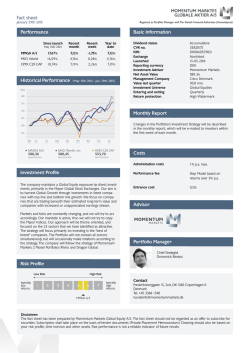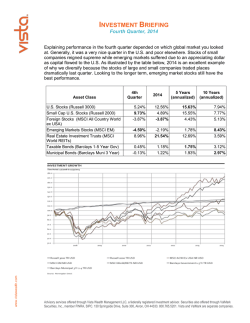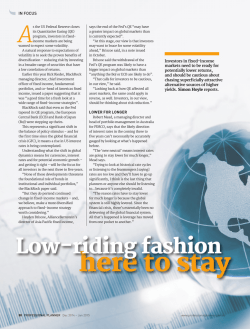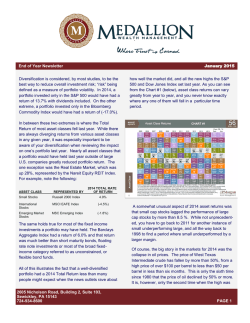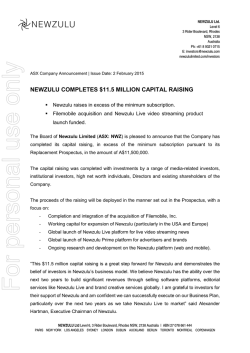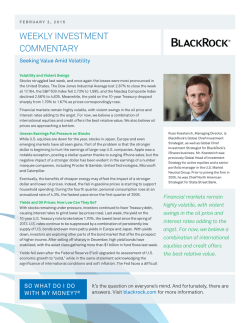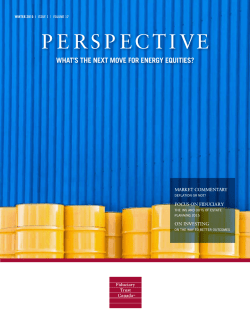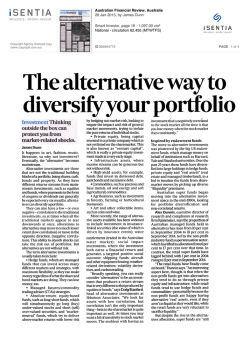
Managing Risk
Managing Risk How a diversified portfolio protects you from economic and behavioral pitfalls Raymond Kerzérho, MBA, CFA Director of Research PWL CAPITAL INC. Dan Bortolotti Investment Advisor PWL CAPITAL INC. January 2015 This report was written by Raymond Kerzérho, PWL Capital Inc. and Dan Bortolotti, PWL Capital Inc. The ideas, opinions, and recommendations contained in this document are those of the authors and do not necessarily represent the views of PWL Capital Inc. © PWL Capital Inc. All rights reserved. No part of this publication may be reproduced without prior written approval of the author and/or PWL Capital. PWL Capital would appreciate receiving a copy of any publication or material that uses this document as a source. Please cite this document as: Raymond Kerzérho, Director of Research, PWL Capital Inc. and Dan Bortolotti, Investment Advisor, PWL Capital Inc. “Managing Risk: How a diversified portfolio protects you from economic and behavioral pitfalls” For more information about this or other publications from PWL Capital, contact: PWL Capital – Montreal, 3400 de Maisonneuve O., Suite 1501, Montreal, Quebec H3Z 3B8 Tel 514 875-9611 • 1-800 875-7566 Fax 514 875-9611 PWL Capital – Toronto, Church Street, Suite 601, Toronto, Ontario M5E 1M2 Tel 416 203-0067 • 1-866 242-0203 Fax 416 203-0544 [email protected] This document is published by PWL Capital Inc. for your information only. Information on which this document is based is available on request. Particular investments or trading strategies should be evaluated relative to each individual’s objectives, in consultation with the Investment Advisor. Opinions of PWL Capital constitute its judgment as of the date of this publication, are subject to change without notice and are provided in good faith but without responsibility for any errors or omissions contained herein. This document is supplied on the basis and understanding that neither PWL Capital Inc. nor its employees, agents or information suppliers is to be under any responsibility of liability whatsoever in respect thereof. All large investment institutions—including banks, pension funds and insurance companies—devote significant resources to risk management. Most have entire departments—including some of their best people—charged with that responsibility. These organizations are highly motivated to maximize return, but they also understand the need to control risk. Managing risk is just as important for individuals: to produce the highest possible long-term returns, their portfolios must avoid crippling losses. But unlike institutions, individuals rarely have a deep understanding of risk in all its forms, and they are often ill-equipped to manage it effectively. In this paper we share our reflections about the various forms of risk and the best strategies for dealing with them. What is risk? There is no single measure of risk. If you need proof, browse the prospectus of any mutual fund and you’ll find a long list of risks inherent in investing. Many involve the possibility of losing money—whether permanently or over short periods—but that is not the only type of risk. In the investment industry, the discussion of risk often centres around volatility, or the variability of returns. Stocks have delivered annualized returns of about 8% to 10% over the very long term, but the returns in any given year vary enormously. One-year returns often exceed 20%, and over other periods (including the financial crisis of 2008–09) stocks can lose 40% to 50% of their value in a matter of months. Meanwhile, Treasury bills or savings accounts will deliver returns that are known in advance, and they have virtually no chance of loss. T-bills and cash are sometimes even referred to as “riskless assets.” But consider an investor who diligently saves for retirement and invests only in T-bills or cash. While she may experience little or no volatility, she is also likely to earn an extremely low return: indeed, once accounting for inflation (which has averaged about 2% in recent decades) she is likely to lose purchasing power and may be unable to fund her retirement. Investors cannot ignore this type of risk. We therefore prefer a broader definition that covers more than volatility and the possibility of losses: risk is what stands between investors and their financial goals. Ignoring, avoiding and managing risk There are three ways to deal with risk. The first is to ignore it by choosing investments that might pay off handsomely but also carry the possibility of total loss. Consider investors who put all of their money in Nortel, Enron or other companies that once seemed safe but ultimately went bankrupt. Ignoring risk introduces the possibility of losing your wealth for good. A second way to deal with risk is to avoid it: for example, investing only in Treasury bills, GICs, or savings accounts that are unlikely to suffer losses. As we have argued, this strategy can eliminate the possibility of losing everything, but it also is likely to result in a dismal long-term return. The third way to deal with risk is to manage it. This starts with distinguishing between the risks that are likely be rewarded over the long-term and those that are not. Then it means building a portfolio that sets an appropriate limit on the amount you can lose in the short-term. Finally, it means using a thoughtful process that ensures the portfolio will be positioned to recover from difficult periods in the markets. Managing Risk 3 Managing risk is not as easy as it sounds: it requires a willingness to endure painful losses over the short-term (which can be as long as several years) and the discipline to stick to a long-term strategy. Many investors look for shortcuts, and the investment industry panders to them by peddling products that promise high returns with little risk. Principal-protected notes, hedge funds and guaranteed income products are often guilty of implying that you can achieve equity-like returns with bond- or GIC-like risk. We do not believe any product can deliver on this promise. CHART 1: $100 INVESTED SINCE 1970 Risk managed Risk avoided Risk ignored Source : Morningstar Direct Chart 1, above, illustrates the possible effects of handling risk in these different ways. Ignoring risk introduces the possibility of losing all your capital: in the chart, $100 invested in 1970 has become $0. Risk avoidance, meanwhile, may lead to investment returns equivalent to those of Treasury bills (grey line). Managing risk—by investing in a broadly diversified portfolio—involves much greater variability from year to year, but also helps investors achieve returns similar to those of the overall markets (blue, green and red lines). Economic risks Many types of risk originate in the broader economy. While investors have no control over economic conditions, they can build portfolios that are robust enough to withstand all but the most devastating events. The following are the primary sources of economic risk: Recessions. Stock prices can decline severely during economic recessions. Chart 2, below, reveals what would have happened to a $100,000 investment in U.S. stocks during three of the worst recessions of the last 100 years: the 1930–32 Great Depression, the 1973-74 oil embargo and, the 2008–09 financial crisis. Declines ranged from 45% to 70% over periods between 15 and 30 months. In all cases, the index took several years to recover. 4 Managing Risk CHART 2: $100,000 INVESTED IN THE S&P 500 DURING THREE MAJOR RECESSIONS Source : Morningstar Direct, PWL Capital. High inflation. Inflation can seriously damage all investment returns, but it is particularly hard on bonds. Chart 3, below, provides an example of how rising inflation can impact the returns of long-dated bonds. From 1950 to 1980, the average inflation rate in the U.S. rose from 1% to 13%. The nominal return (blue line) on bonds during this period was just over 2% annually. But because of the significant rise in inflation—about 4% during this period—the present value of the bonds’ interest payments declined significantly: future payments could purchase fewer and fewer goods. As a result, after accounting for inflation, the value of a $100,000 investment in long-term U.S. Treasury bonds (red line) fell to $60,000 after 30 years. CHART 3: $100,000 INVESTED IN LONG-TERM U.S. TREASURY BONDS 1950–80 Source : Morningstar Direct Managing Risk 5 Wars and political turmoil. Stock market returns reflect the profits of the underlying companies. When plants, equipment and other property are destroyed by war, profits will obviously be expected to decrease. Other political events can also lead to the confiscation of investors’ money. An example is the Russian revolution of 1917, when the country rapidly turned from a market economy to a communist system. After the revolution, holders of Russian stocks and bonds never saw their money returned. Chart 4, below, ranks the returns of 16 national stock markets (net of inflation) from 1900 to 2012. Notice that the countries with the lowest returns experienced major destruction (World War II for Italy, Belgium, France and Germany; the 1930s civil war in Spain) while the top-performing countries were largely spared from wars fought on home soil. CHART 4: REAL RETURN ON EQUITIES 1900–2012 War-Torn Non War-Torn Source : London Business School Behavioural risks Not all of the risks faced by investors originate in the economy. As Benjamin Graham wrote: “The investor’s chief problem—even his worst enemy—is likely to be himself.” Even during periods of economic prosperity and booming markets, many investors experience low returns because of destructive behavior. Most behavioural risks fall into one of these categories: Concentration. Investors are often tempted to concentrate their portfolios in a small number of stocks in the hopes hitting the jackpot with a Google, Apple or other ten-bagger. They are driven by a combination of greed and overconfidence in their ability to identify the next big winner. On average, one should expect a well-diversified portfolio to have an expected return similar to that of a concentrated one. But the concentrated portfolio has much greater upside and downside potential. Unfortunately, some investors are attracted to the former and ignore the latter. 6 Managing Risk Market timing. Many investors believe they can forecast the markets’ ups and downs and take advantage by buying and selling at opportune times. But the evidence is clear: no one can consistently profit by forecasting the direction of the markets. Indeed, market timing frequently leads to opportunity cost, such as sitting in cash during a period when the equity markets rise sharply. To offer one recent example, some investors believed U.S. stocks were overvalued at the end of 2012 and reduced their holdings, only to see this asset class return over 40% (in Canadian dollar terms) the following year. Active trading. The case against active trading is equally compelling. Security prices are determined by millions of market participants, and while markets are not perfectly efficient, it is extremely difficult to identify and exploit mispricings. No one should expect to profit from active trading over the long term, except the brokers who pocket a commission for every trade, and the governments that collect revenue from taxable capital gains. Active traders also tend to be more emotional about their investments, acting out of fear and greed rather than following a disciplined long-term strategy. Managing economic and behavioural risk Given this range of economic and behavioural pitfalls, how can investors manage these risks and maximize their long-term returns? We offer the following suggestions. Start with an appropriate asset mix—and stick to it. For all investors—from the largest pension funds to the individual saving for retirement—the primary portfolio decision is determining the appropriate mix of stocks and bonds. This crucial decision should be made only after careful planning that assesses your ability, willingness and need to take risk. Once you’ve established a target asset allocation, it should not change because of market conditions. However, over time your portfolio will naturally drift away from its target asset mix as stocks and bonds deliver different rates of return. Occasional rebalancing—trimming overweight asset classes and using the proceeds to prop up lagging ones—reduces risk and may even boost returns. For details see our earlier white paper, The Art of Profitable Rebalancing. Write an investment policy statement. Once you have decided on your stock/bond mix, put it in writing. An investment policy statement (IPS) should outline the details of your strategy: the asset allocation, return objective, risk constraints, time horizon, tax considerations, and so on. Having a written document will help you stick to your strategy in times of market stress. Keep your bonds safe. Bonds should be the anchor in your portfolio, while equities are the riskier, “return-seeking” assets. This may seem obvious, but many investors take significant risk with their bond allocation, most often by using high-yield corporate bonds that carry significant risk of default. They are attracted by the extra yield, but often don’t realize how much damage credit risk can do during recessions. In 2008–09, for example, high-yield bonds fell sharply along with stocks, while government bonds rose in value and offered a safety net. We recommend keeping your fixed income portfolio safe by sticking to federal and provincial government bonds with maturities up to 10 years. GICs are also a safe alternative, but should be held within CDIC insurance limits. If you invest in corporate bonds, use a diversified fund of investment-grade (high-quality) issues to minimize default risk. Embrace only compensated risks. Increasing the expected return of your portfolio usually requires taking more risk. That may mean raising the allocation to equities, choosing corporate bonds over governments, or long bonds over those with shorter maturities. But not all risks are compensated with greater long-term rewards: the evidence suggests that the risks associated with portfolio concentration and market timing, for example, do not increase expected return. Managing Risk 7 TABLE 1: COMPENSATED VS. UNCOMPENSATED RISKS COMPENSATED UNCOMPENSATED Bond maturity risk Stock selection risk Bond credit risk Sector concentration risk Equity risk Market-timing risk Small-cap stock risk Value stock risk Source: PWL Capital Investors are often attracted to strategies with large upside potential, such as concentrated portfolios or leverage (borrowing to invest). But these strategies also carry the risk of very large losses. Once you account for this potential downside, the expected return—or the average return for all potential scenarios—is often lower than that of a safer diversified portfolio. Invest in entire asset classes. One of the most common examples of uncompensated risk is buying individual stocks. This leads to higher volatility and greater downside risk, but perhaps just as important, it can lead to detrimental behaviour. Investors tend to fall in love with the winners and refuse to sell stocks at a loss, even when it’s the right thing to do. This tends not to happen when you invest in index or asset-class funds that hold hundreds of securities. When investors hold a total-market U.S. equity fund, for example, they’re not likely to know or care which stocks are driving returns up or down, because they’re focused on getting overall exposure to U.S. stocks. Asset-class funds can remove some of the emotion from the investment process. A portfolio built from asset-class funds also offers diversification benefits from three different angles. It includes hundreds, if not thousands, of securities to shield the portfolio against the risk of individual companies. It is also diversified across all sectors to avoid being derailed by a disaster in any one of them (technology or banking, for example). Finally, the portfolio is diversified geographically to prevent major losses caused by a single country (the Nikkei Stock Average of Japanese stocks, for example, is still at less than half its 1989 value). Review your portfolio. It’s important to measure the performance of your investments at least once a year to make sure your portfolio is doing its job properly. The point is not to expect consistent returns year after year—no portfolio of stocks or bonds will ever do that. Rather the goal is to ensure that your funds are tracking their benchmarks properly and that any losses are within the range you were prepared to accept. Reviewing your strategy regularly—but not too frequently—will help you persevere over time. You may also decide to reconsider your investment policy statement if you’ve had a significant change in your financial life, such as a large inheritance, a new career, divorce, marriage, a new baby, or a windfall from selling your business. You should also revise your investment policy statement if you discover you have overestimated your risk tolerance. Conclusion Investors love risk when stocks skyrocket, and they hate it when they tank. This is an emotional response, not a rational one, and it is one of the most significant obstacles to investing success. As we’ve argued in this paper, the key is not to ignore or avoid risk, but to effectively manage it. Investors need to embrace compensated risks to capture the returns of the stock and bond markets, but they must also be careful to avoid overexposure to any single risk. The best way to achieve these goals is to build a properly diversified portfolio and execute it with discipline. 8 Managing Risk Raymond Kerzérho, MBA, CFA Director of Research PWL CAPITAL INC. [email protected] https://www.pwlcapital.com/Kerzerho-blog Dan Bortolotti Investment Advisor PWL CAPITAL INC. [email protected] www.canadiancouchpotato.com Portfolio Management and brokerage services are offered by PWL Capital Inc., which is regulated by Investment Industry Regulatory Organization of Canada (IIROC), and is a member of the Canadian Investor Protection Fund (CIPF). Financial planning and insurance products are offered by PWL Advisors Inc., and is regulated in Ontario by Financial Services Commission of Ontario (FSCO) and in Quebec by the Autorité des marchés financiers (AMF). PWL Advisors Inc. is not a member of CIPF. Managing Risk 9 PWL Montreal 3400 de Maisonneuve O. Suite 1501 Montreal, Quebec H3Z 3B8 PWL Ottawa 265 Carling Avenue Suite 401 Ottawa, Ontario K1S 2E1 PWL Toronto 3 Church Street Suite 601 Toronto, Ontario M5E 1M2 PWL Waterloo 20 Erb St. W, Suite 506 Waterloo, Ontario N2L 1T2 T 514.875.7566 T 613.237.5544 T 416.203.0067 T 519.880.0888 F 514.875.9611 [email protected] F 613.237.5949 [email protected] F 416.203.0544 [email protected] F 519.880.9997 [email protected] www.pwlcapital.com/Montreal www.pwlcapital.com/Ottawa www.pwlcapital.com/Toronto www.pwlcapital.com/Waterloo 1-800.875.7566 1-800.230.5544 1-866.242.0203 1.877.517.0888
© Copyright 2025
